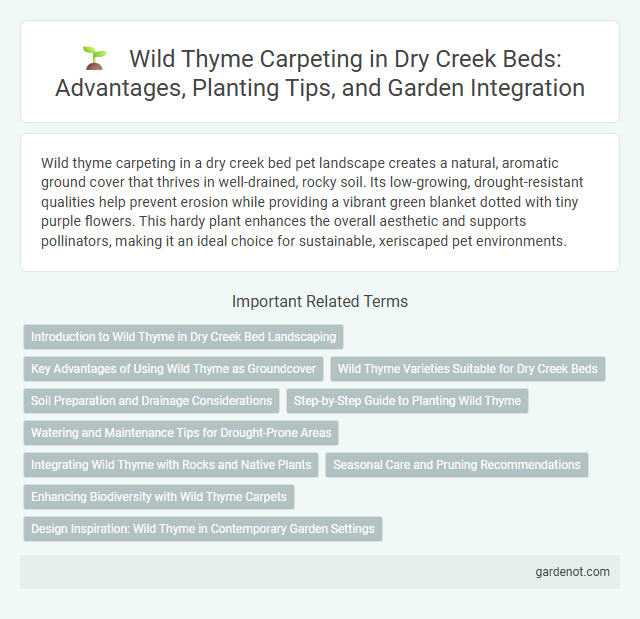Wild thyme carpeting in a dry creek bed pet landscape creates a natural, aromatic ground cover that thrives in well-drained, rocky soil. Its low-growing, drought-resistant qualities help prevent erosion while providing a vibrant green blanket dotted with tiny purple flowers. This hardy plant enhances the overall aesthetic and supports pollinators, making it an ideal choice for sustainable, xeriscaped pet environments.
Introduction to Wild Thyme in Dry Creek Bed Landscaping
Wild thyme thrives in dry creek bed landscaping due to its drought resistance and low maintenance requirements. This aromatic ground cover provides vibrant purple blooms and dense foliage that stabilize soil and prevent erosion. Its ability to withstand harsh sunlight and poor soil conditions makes it an ideal addition to dry creek beds, enhancing both aesthetics and functionality.
Key Advantages of Using Wild Thyme as Groundcover
Wild thyme as groundcover offers exceptional drought tolerance and requires minimal maintenance, making it ideal for dry creek beds. Its dense growth habit effectively prevents soil erosion while promoting biodiversity by attracting pollinators like bees and butterflies. The aromatic foliage provides natural pest resistance, enhancing both the ecological and aesthetic value of dry landscapes.
Wild Thyme Varieties Suitable for Dry Creek Beds
Wild thyme varieties such as Thymus serpyllum, Thymus praecox, and Thymus vulgaris thrive in dry creek beds due to their drought tolerance and low water requirements. These groundcovers feature dense, aromatic foliage and vibrant flowers that help stabilize soil while adding natural color to arid landscapes. Selecting native or adapted wild thyme species enhances erosion control and supports pollinator habitats in dry creek environments.
Soil Preparation and Drainage Considerations
Wild thyme carpeting thrives in well-drained, sandy or gravelly soils typical of dry creek beds, requiring minimal organic matter to prevent water retention. Soil preparation should involve loosening the substrate to enhance aeration and ensure rapid drainage, avoiding compaction that can cause root rot. Proper grading and incorporation of coarse materials like sand or small stones improve infiltration, promoting healthy growth and drought resilience.
Step-by-Step Guide to Planting Wild Thyme
Wild thyme carpeting thrives in dry creek beds due to its low water requirements and excellent drought tolerance. To plant wild thyme, begin by preparing well-drained, sandy soil and clearing the area of weeds and debris. Scatter seeds or plant small plugs evenly, pressing them gently into the soil, then water lightly to encourage germination and root establishment.
Watering and Maintenance Tips for Drought-Prone Areas
Wild thyme carpeting thrives in dry creek beds, requiring minimal watering due to its drought-resistant nature. Water deeply but infrequently, allowing the soil to dry out between sessions to prevent root rot. Regularly trim the thyme to encourage dense growth and remove any dead stems, maintaining its vibrant ground cover in arid environments.
Integrating Wild Thyme with Rocks and Native Plants
Wild thyme thrives in the rocky terrain of dry creek beds, creating a vibrant carpet that stabilizes soil and reduces erosion. Integrating wild thyme with native plants like sedum and lavender enhances biodiversity while complementing the natural stone features. This combination provides drought-tolerant ground cover that thrives in full sun and well-drained conditions, supporting pollinators and adding textural contrast.
Seasonal Care and Pruning Recommendations
Wild thyme carpeting thrives in well-drained soil typical of dry creek beds, requiring minimal watering during dry seasons to prevent root rot. Prune after flowering in late spring to maintain a dense, low-growing cover and stimulate fresh growth. Seasonal care includes removing debris and cutting back any woody stems in early fall to prepare the plant for winter dormancy.
Enhancing Biodiversity with Wild Thyme Carpets
Wild thyme carpets create a dense, fragrant ground cover that supports pollinators and beneficial insects, enhancing biodiversity in dry creek bed environments. Its drought-resistant nature and low growth habit help stabilize soil and reduce erosion while providing habitat for small wildlife. Incorporating wild thyme in landscaping increases ecological resilience by fostering a diverse ecosystem of plants and animals.
Design Inspiration: Wild Thyme in Contemporary Garden Settings
Wild thyme carpeting offers a vibrant, low-maintenance ground cover that enhances contemporary garden designs with its dense foliage and tiny purple blooms. Its drought-tolerant and hardy nature makes it ideal for dry creek beds, creating a naturalistic yet structured aesthetic. Incorporating wild thyme provides ecological benefits by attracting pollinators while adding texture and color contrast to minimalist landscaping.
Wild thyme carpeting Infographic

 gardenot.com
gardenot.com